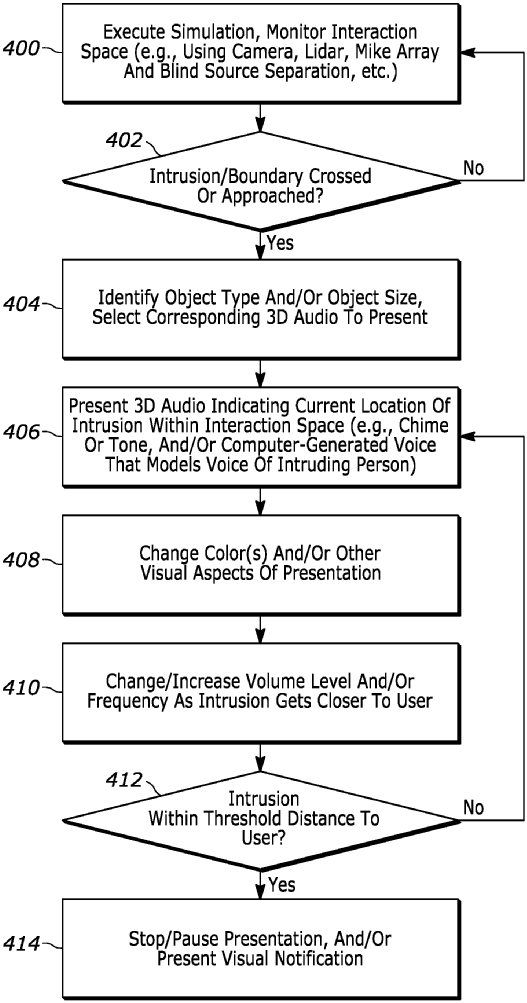
Story Highlights
- Sony has published a new patent that seeks to add the ability for the VR headset to recognize approaching objects as the user is immersed in the experience.
- The VR headset could become capable of alerting the user of any humans or animals nearby using a dynamic 3D audio system.
- Sony also discusses another patent that wants to alert the user of any dangers by using a dynamic notification pop-up system.
- We could see the implementation of the discussed patents in a new PSVR 2 model in the future or in any of the subsequent headsets.
Sony has recently published two patents that discuss scanning the area of a user using a VR headset. The environment will be scanned, and if an outsider enters the designated area, a notification will alert the user of the danger. The danger could be a pet, a baby, or anyone else in the vicinity of the user walking too close to their TV during a gameplay session. It’s intended to keep users aware of their real-life environment while playing.
The patent will attempt to solve the dilemma by alerting the user of impending danger that may abruptly result in an accident. The first legal document, dubbed “3D AUDIO FOR DETECTING OBJECTS IN DANGER ZONES AROUND VR PLAYERS,” will play 3D audio after discovering any object the user could collide with while enjoying a VR game. The audio will dynamically let the user know if anything enters the personal space.
Three-dimensional (3D) audio can be presented during an augmented reality, mixed reality, or virtual reality simulation to notify a user that a real-world object is approaching or has crossed a boundary for an interaction space within which the user is to interact with the simulation. The 3D audio may indicate the current location of the intrusion or boundary while still leaving the user immersed in the simulation.”
The 3D audio can include a chime or a tone, and the prospect of a computer-generated voice is also discussed in the patent. Moreover, the audio volume could greatly differ based on the intrusion level. For instance, if a dangerous object is on the outskirts of the vicinity, the volume could be mellow to reflect the level of danger. It is also possible to increase the volume as the real-world object slates closer to the user’s personal space.

Similarly, the frequency of the chimes could also vary depending on the distance of the real-life object that could collide with the user. Sony also discusses playing different 3D audios for different objects to ensure the user can somewhat differentiate while immersed in a video game or any other mixed reality experience. The volume and frequency of the audio could also change based on the size of the object that can unexpectedly hit the user.

The 3D audio can utilize the voice of the user or in-game character to let the players know of any potential dangers. For instance, Sony uses the example of a notification saying, “your son is behind you,” to alert the user of their kid behind them by accurately discovering the baby. The patent discusses using AI models to implement the alluring technology.

Sony’s patent seeks to ensure that the user currently immersed in a VR session does not have to stop or pause the experience to deal with real-life intrusions, which is usually how VR users deal with the environment currently. Taking the VR headsets off while enjoying a game breaks the immersion and disrupts the user experience. Thus, the 3D audio will remove the need to take off the headset by dynamically alerting the users of potential dangers.
The second patent published by Sony, named “DYNAMIC NOTIFICATION SURFACING IN VIRTUAL OR AUGMENTED REALITY SCENES,” also discusses a similar innovation, but it seeks to alert the user by using a dynamic notification pop-up system instead of 3D audio. The alert can use a textual or a non-text bubble that represents a graphical object that could be approaching the player that is currently immersed in a VR session.
A non-text notification bubble or other graphical object can be presented during an augmented reality, mixed reality, or virtual reality simulation to notify a user that a real-world object is approaching or has crossed a boundary for an interaction space within which the user is to interact with the simulation.”
The dynamic notification bubble may pop up multiple times after a certain time passes if the user does not respond to it in the allotted span. The next alerts may also include haptic feedback to let the user know of the coming danger that can collide with them. Sony discusses detecting one or more real-life objects that approach the user, and the alerts will stop when the user deals with the object by either placing it away or moving to some other area.

The game or any virtual content could slow down as the user deals with the intrusion that entered the vicinity without taking off the headset. As described in the first patent, Sony wants to solve the same problem, but by applying a different style of notifications.
We can expect Sony to implement the innovative technology in a future PSVR 2 model or in any of the planned headsets for the future. It could revolutionize the way VR and AR technology is currently used by gamers and other target audiences.
Similar Reads: Steam PC To Get A Notification Page And Game Notes Feature, Hints Datamine.
Thanks! Do share your feedback with us. ⚡
How can we make this post better? Your help would be appreciated. ✍



